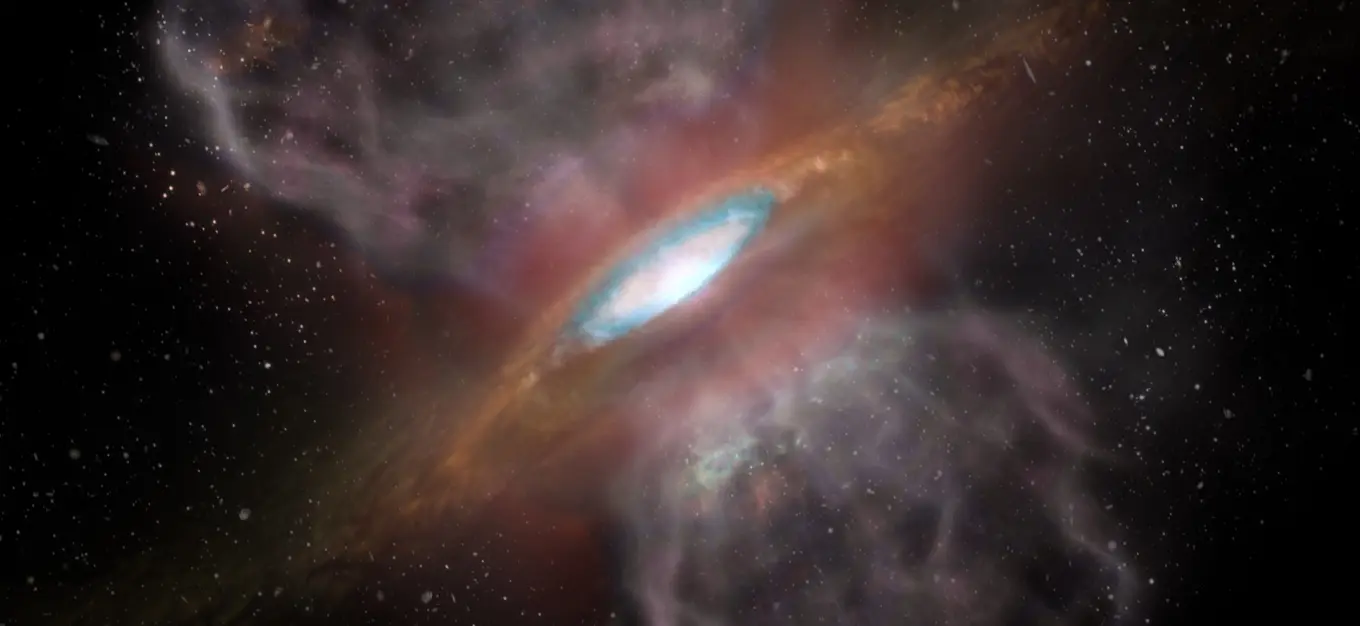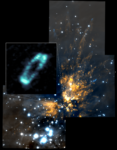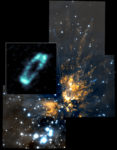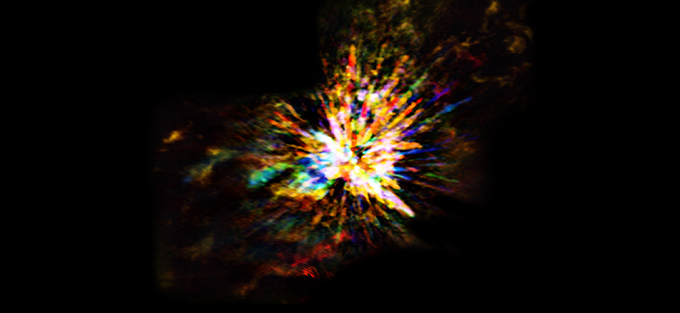Liberal Sprinkling of Salt Discovered around a Young Star
A team of astronomers and chemists using the Atacama Large Millimeter/submillimeter Array (ALMA) has detected the chemical fingerprints of sodium chloride (NaCl) and other similar salty compounds emanating from the dusty disk surrounding Orion Source I, a massive, young star in a dusty cloud behind the Orion Nebula.
“It’s amazing we’re seeing these molecules at all,” said Adam Ginsburg, a Jansky Fellow of the National Radio Astronomy Observatory (NRAO) in Socorro, New Mexico, and lead author of a paper accepted for publication in the Astrophysical Journal. “Since we’ve only ever seen these compounds in the sloughed-off outer layers of dying stars, we don’t fully know what our new discovery means. The nature of the detection, however, shows that the environment around this star is very unusual.”
To detect molecules in space, astronomers use radio telescopes to search for their chemical signatures – telltale spikes in the spread-out spectra of radio and millimeter-wavelength light. Atoms and molecules emit these signals in several ways, depending on the temperature of their environments.
The new ALMA observations contain a bristling array of spectral signatures – or transitions, as astronomers refer to them – of the same molecules. To create such strong and varied molecular fingerprints, the temperature differences where the molecules reside must be extreme, ranging anywhere from 100 kelvin to 4,000 kelvin (about -175 Celsius to 3700 Celsius). An in-depth study of these spectral spikes could provide insights about how the star is heating the disk, which would also be a useful measure of the luminosity of the star.
“When we look at the information ALMA has provided, we see about 60 different transitions – or unique fingerprints – of molecules like sodium chloride and potassium chloride coming from the disk. That is both shocking and exciting,” said Brett McGuire, a chemist at the NRAO in Charlottesville, Virginia, and co-author on the paper.
The researchers speculate that these salts come from dust grains that collided and spilled their contents into the surrounding disk. Their observations confirm that the salty regions trace the location of the circumstellar disk.
“Usually when we study protostars in this manner, the signals from the disk and the outflow from the star get muddled, making it difficult to distinguish one from the other,” said Ginsburg. “Since we can now isolate just the disk, we can learn how it is moving and how much mass it contains. It also may tell us new things about the star.”
The detection of salts around a young star is also of interest to astronomers and astrochemists because some of constituent atoms of salts are metals – sodium and potassium. This suggests there may be other metal-containing molecules in this environment. If so, it may be possible to use similar observations to measure the amount of metals in star-forming regions. “This type of study is not available to us at all presently. Free-floating metallic compounds are generally invisible to radio astronomy,” noted McGuire.
The salty signatures were found about 30 to 60 astronomical units (AU, or the average distance between the Earth and the Sun) from the host stars. Based on their observations, the astronomers infer that there may be as much as one sextillion (a one with 21 zeros after it) kilograms of salt in this region, which is roughly equivalent to the entire mass of Earth’s oceans.
“Our next step in this research is to look for salts and metallic molecules in other regions. This will help us understand if these chemical fingerprints are a powerful tool to study a wide range of protoplanetary disks, or if this detection is unique to this source,” said Ginsburg. “In looking to the future, the planned Next Generation VLA would have the right mix of sensitivity and wavelength coverage to study these molecules and perhaps use them as tracers for planet-forming disks.”
Orion Source I formed in the Orion Molecular Cloud I, a region of explosive starbirth previously observed with ALMA. “This star was ejected from its parent cloud with a speed of about 10 kilometers per second around 550 years ago,”[1. Light from this object took about 1,500 years to reach Earth. Astronomers are seeing it as if looking through that window of time, which reveals how it looked 550 years after it was ejected from its stellar nursery] said John Bally, an astronomer at the University of Colorado and co-author on the paper. “It is possible that solid grains of salt were vaporized by shock waves as the star and its disk were abruptly accelerated by a close encounter or collision with another star. It remains to be seen if salt vapor is present in all disks surrounding massive protostars, or if such vapor traces violent events like the one we observed with ALMA.”
Additional information
“Orion SrcI’s disk is salty,” A. Ginsburg, et al., 2019 Feb. 7, Astrophysical Journal
The Atacama Large Millimeter/submillimeter Array (ALMA), an international astronomy facility, is a partnership of the European Organisation for Astronomical Research in the Southern Hemisphere (ESO), the U.S. National Science Foundation (NSF) and the National Institutes of Natural Sciences (NINS) of Japan in cooperation with the Republic of Chile. ALMA is funded by ESO on behalf of its Member States, by NSF in cooperation with the National Research Council of Canada (NRC) and the Ministry of Science and Technology (MOST) in Taiwan and by NINS in cooperation with the Academia Sinica (AS) in Taiwan and the Korea Astronomy and Space Science Institute (KASI).
ALMA construction and operations are led by ESO on behalf of its Member States; by the National Radio Astronomy Observatory (NRAO), managed by Associated Universities, Inc. (AUI), on behalf of North America; and by the National Astronomical Observatory of Japan (NAOJ) on behalf of East Asia. The Joint ALMA Observatory (JAO) provides the unified leadership and management of the construction, commissioning and operation of ALMA.
Images and video
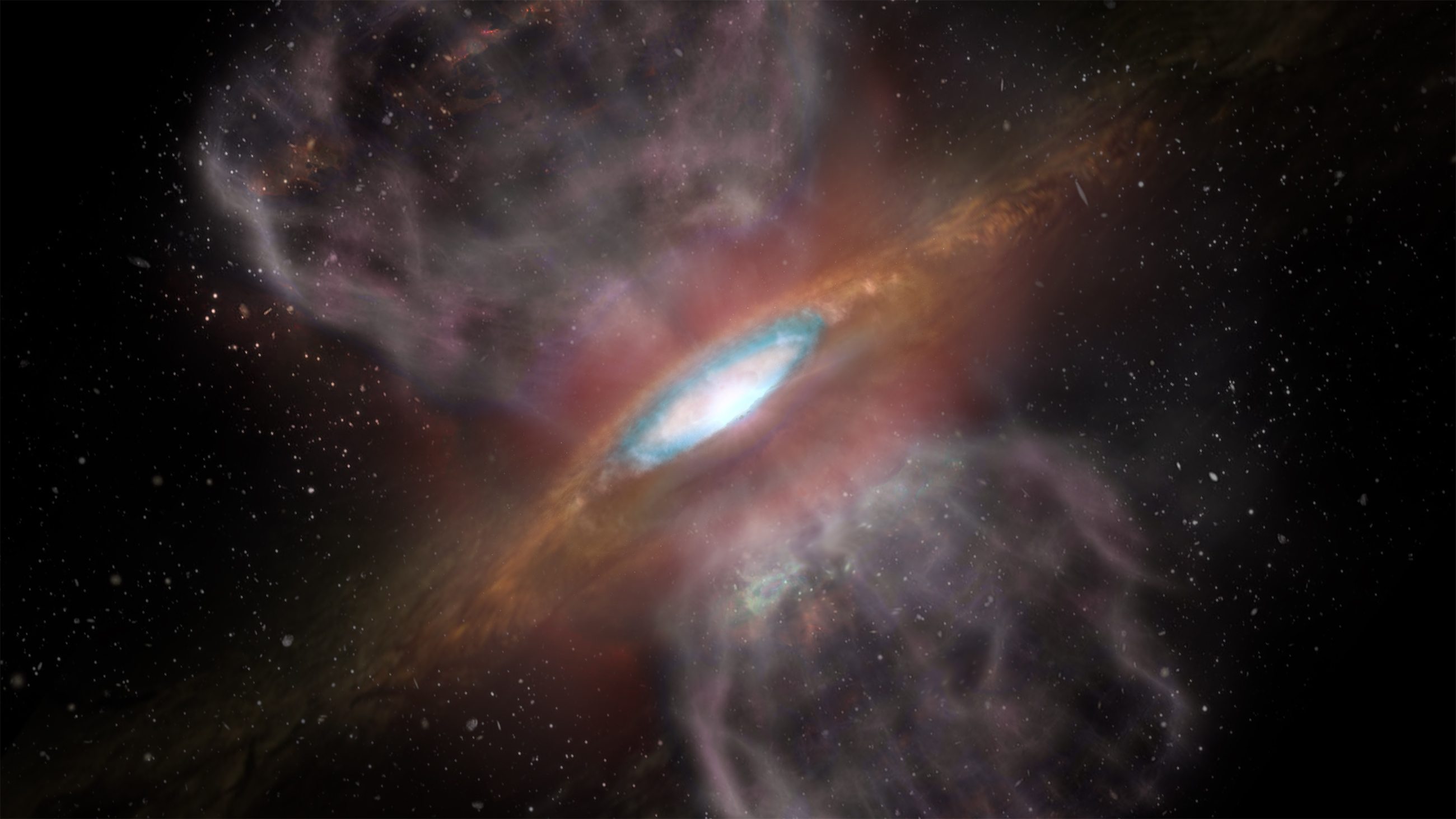
Artist impression of Orion Source I, a young, massive star about 1,500 light-years away. New ALMA observations detected a ring of salt -- sodium chloride, ordinary table salt -- surrounding the star. This is the first detection of salts of any kind associated with a young star. The blue region (about 1/3 the way out from the center of the disk) represents the region where ALMA detected the millimeter-wavelength "glow" from the salts. Credit: NRAO/AUI/NSF; S. Dagnello
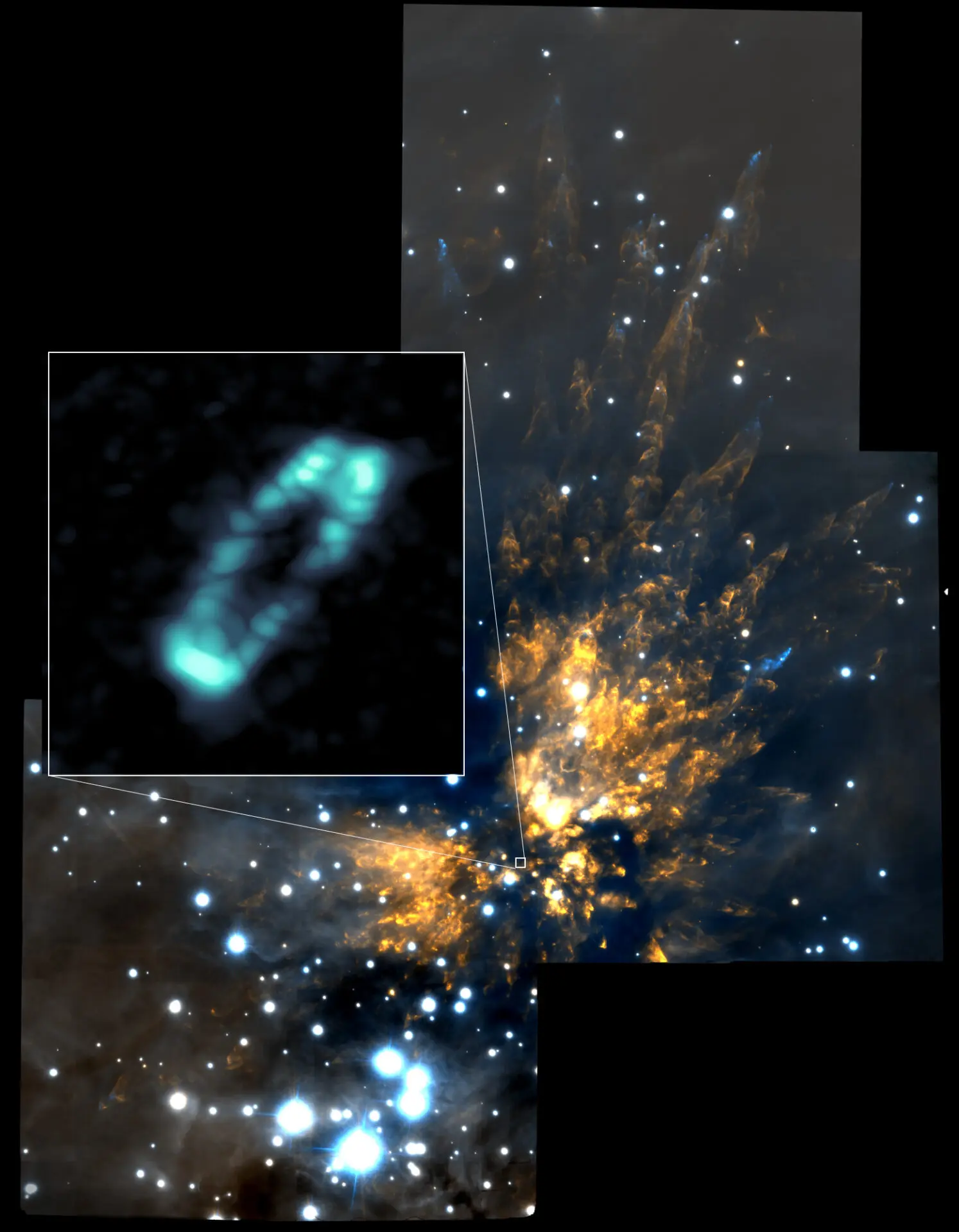
ALMA image of the salty disk surrounding the young, massive star Orion Source I (blue ring). It is shown in relation to the Orion Molecular Cloud 1, a region of explosive starbirth. The background near infrared image was taken with the Gemini Observatory. Credit: ALMA (NRAO/ESO/NAOJ); NRAO/AUI/NSF; Gemini Observatory/AURA
New ALMA observations show there is ordinary table salt in a not-so-ordinary location: 1,500 light-years from Earth in the disk surrounding a massive young star.
Credit: ALMA (NRAO/ESO/NAOJ); NRAO/AUI/NSF; Gemini Observatory/AURA
Contacts
-
Valeria Foncea
Education and Public Outreach ManagerJoint ALMA Observatory Santiago - ChilePhone: +56 2 2467 6258Cel: +56 9 7587 1963Email: [email protected] -
Charles E. Blue
Public Information OfficerNational Radio Astronomy Observatory Charlottesville, Virginia - USAPhone: +1 434 296 0314Cel: +1 202 236 6324Email: [email protected] -
Calum Turner
ESO Assistant Public Information Officer -
Masaaki Hiramatsu
Education and Public Outreach Officer, NAOJ Chile
